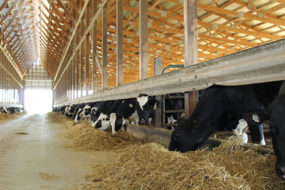Over the past five years, genomics has received a lot of publicity as a tool to help manage your herd’s genetics. Whether it is determining an overall breeding strategy for your herd or trying to find that high-end outlier that brings tens of thousands of dollars at a cattle sale, there is no doubt genomics has revolutionized the way producers look at dairy genetics.
Because of genomics, there are producers discussing the genetics of their herd today that would not have known a genetic index if it looked them in the face five years ago. So genomics is a good thing. A rising tide lifts all ships.
But all of this comes at a cost. A cost that can be mitigated in the short term if producers look to the source of genomic data and consider this an option.
Dairy producers are familiar with the traditional indexes, such as predicted transmitting ability (PTA) for milk, fat, protein, net merit, etc.
While one is quick to defer to the additional traits that can come from genomic testing as well as the increased reliability, parent averages can provide a useful alternative as long as the identification of the parents is accurate and you are not looking for the next outlier super-cow.
Producers that have managed their genetics using both methods – traditional indexes and genomics – indicate that, for the purposes of sorting animals as part of a breeding strategy, traditional parent averages can provide the data to segment the herd into breeding management groups.
Producers can take advantage of the data already available and consider using some of the genomic dollars for investing in the genetics of their herd through the use of better bulls.
One breeding strategy some producers are using includes identifying the top 50 percent of the animals by PTA milk and using sexed semen on those animals in order to advance their genetics. For example, instead of spending $40 on a genomic test, invest that $40 in good bulls.
Source of traditional indexes
Traditional indexes are updated three times a year – with the release of the Council on Dairy Cattle Breeding genetic evaluations – in April, August and December. However, as long as an animal’s sire and dam have genetic evaluations, parent averages can be calculated at any time.
So what does it take to get a traditional evaluation? Evaluations are provided for cows as part of the U.S. DHIA program. Any herd that has their production records collected by a certified field service, components analyzed by a certified laboratory and processed by a records processing center is eligible to receive the traditional indexes as part of the reports and download files.
As part of the service to herds, producers can get a list of their youngstock by Net Merit and receive an index file that contains as many as seven different traits on not only the heifer but the dam and the sire as well.
Net Merit values are available in the traditional test-day download file. And the index file can be imported into herd management programs to help incorporate other data into the reproductive strategy.
In the low-tech world, these indexes on milking cows appear in the traditional cow page offered by most official records processing centers.
If you are already testing and processing your records, indexes are a part of the program as long as cows are properly identified (unique identifier on the cow and a sire’s NAAB code).
If you are testing with DHIA but not processing your records, the proper identification noted above and about 10 cents per cow per test will get you those results. If you are not currently testing at all, then there is the cost of testing as well as processing your herd records. That cost can be quite variable based on herd size.
Actual strategy
So how would you use this information as part of your breeding program? First of all, as you look at your replacements, do yourself a favor and get rid of the runts, the ones that have had pneumonia and any animal that is not performing the way you think it should grow. Nine times out of 10, those animals are going to be duds anyway.
Secondly, what traits are financially important to your operation? A lot of producers seem to be comfortable with Net Merit Dollars, Holstein’s Total Performance Index or the Jersey Performance Index. They are what is referred to as a composite index and will, without a doubt, lead you in a right direction.
There are critics of the composite indexes who allege there is too much type data in the composite indexes and the type is inherent in most animals in the dairy population today. You need to look at your cows and make those decisions.
In a fluid market, producers may choose to emphasize PTA milk. Others may choose to emphasize components if producing for a cheese market. But it is best not to rely on one single trait and to consider other important traits like udders and feet and legs when making breeding choices.
Thirdly, what are your overall dairy growth plans? Are you looking to increase the size of the herd? Maintain status quo? A suggested strategy of breeding the top one-third to sexed semen, the middle one-third to non-sexed semen and the bottom one-third to beef sires may not be the best strategy if you are looking to increase the size of your herd. If you are in a growth mode, perhaps you will want to breed the top half of the herd to sexed semen.
Some struggle with the beef semen option on the lower end. When dairy springers bring $2,500 to $3,000, one has to question the merit of breeding the lower genetic end of the herd to beef bulls.
However, when springers are not worth the cost of raising them, the beef semen option looks like a viable alternative. The beef cross will bring you a premium in the bull calf market. As long as you can look into the crystal ball and know when those springer prices are going to increase, then the breeding decision should be easy.
Other benefits
Once you have committed to having your records processed by a processing center, there are other benefits that accrue at little or no additional costs. There are consultants that like the standardized reports, several of which allow you to benchmark your herd against other herds of similar size and geography or even monitor your herd progress over time. These reports can be helpful to determine areas for management attention.
You still may want to genomic test some of the high-end animals to find that top-end outlier. Knowing the parent average of the heifers will make determining who you would like to genomic test a quick decision.
The experts at the Council on Dairy Cattle Breeding indicate that having traditional proofs on the parents of the animal being genomically tested improves the reliability of the genomic results.
And finally, if you have genetic data going into the Council on Dairy Cattle Breeding database, you can earn a discount on their genomic fees simply by having your data contribute to the genetic database.
So as producers look for ways to minimize cost, using traditional genetic indexes to group replacements into different categories can be an option. It is dependent on good sire identification and is less reliable than the genomic result. But it does work, and people have used this for years prior to the introduction of genomics.
You are not going to find that top-end outlier using parent averages, but you will be able to make genetic improvement for a minimal investment in most cases. ![]()
Denise Athy is the marketing representative for AgriTech Analytics.
Bill VerBoort is the general manager at AgriTech Analytics. Email Bill VerBoort.






